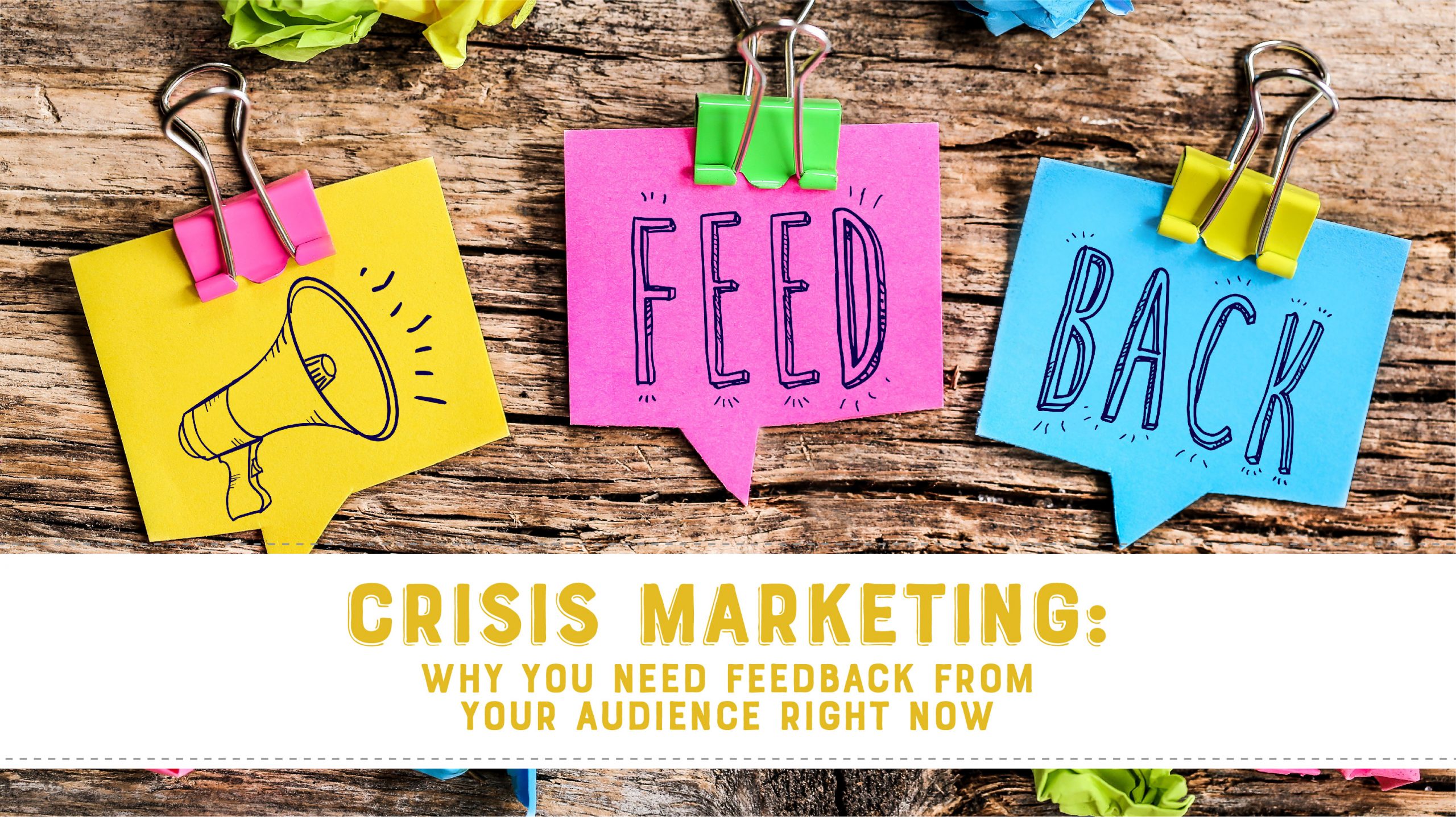Gathering feedback from your audience is always helpful, but especially when events like the COVID-19 pandemic put you into crisis mode. Thanks to the COVID-19, the marketing plans you initially made for 2020 may not be relevant anymore. Your messaging and content likely need some adjustments in order to meet your audience’s needs, which is why getting feedback from your audience is important for your efforts when marketing in a crisis so you can know what they want and need from you. You can watch the recording of our webinar “Crisis Marketing: Why You Need Feedback from Your Audience Right Now” on our YouTube channel or read the recap below to learn more, and be sure to check out our download of resources at the end of this post.
Getting feedback now is critical because it helps you understand what your audience is thinking. None of us have mind-reading super powers, so you have to get your audience talking to you in order to know what they want and need, no matter what the world around us is like. In a time of crisis it’s even more important because things are changing at a rapid pace.

Think back to the Great Recession. As we came out of this period, people trusted differently. Banks and a good deal of corporate branding were in need of repositioning. The old ways they talked to people triggered bad memories from the recession so they had to speak to their audiences in a different way to rebuild that trust. We will have to do this again. We are currently seeing a shift with people right now as they are spending time at home. We don’t know how this will shape all of us, but if we stay in contact with our audiences and keep listening, we can pivot, heal, and grow faster.
Part of listening to your audience means actively seeking feedback and the good news is there are lots of free resources out there, as well as some really cost-effective options if you want or need a few more fancy bells and whistles. That being said, let’s take a look at some of the ways you can collect feedback and the tools available to you.
Polls and Surveys

Before we get into the details, let’s start by distinguishing the difference between a poll and a survey. A poll has only one question and is an easy way to collect feedback about a specific topic. A survey includes multiple questions, can be long or short, and can be anonymous or not. The types of questions in a survey can range from multiple choice to short answer, drop-down options, linear scales and more. Polls are great for quick, immediate responses, while surveys allow your audience to give more thought to the questions you are asking and their responses.
Tools for Polls and Surveys
Here are some tools you can use for creating and sending polls and surveys.
- Doodle Polls: Doodle Polls are quick, simple, and easy to set up. Best of all, there is a free version!
- Facebook: Use your Facebook status update to conduct a poll. In addition to being free, putting a poll in your status update is a good way to drive engagement.
- Instagram Stories: Instagram has several great features in Stories for polling your audience. These “stickers” help generate engagement like Facebook polls and are free!
- Zoom Polls: If you are using Zoom to conduct meetings or webinars, you can poll your audience while the event is taking place. This is a great feature for gathering feedback on your presentation, just to break the ice, or anything you need it to be.
- Easypolls: Easypolls is yet another free option for conducting quick polls.
- Google Forms: If you have a Google account, Google Forms is another great free option. You can use them for polls or surveys and have a variety of options for question responses, including multiple choice, short answer, checkboxes, linear scales, and more.
- Survey Monkey: This platform has multiple pricing tiers and features to help you collect feedback from your audience. In addition to surveys, you can create quizzes and polls and Survey Monkey will help you analyze the results so you can make better decisions.
- Wufoo: Wufoo is a product of Survey Monkey and is another surveying platform that comes at multiple price points and offers customization for questions and fields, as well as the ability to add your branding.
When to Survey Your Audience

When it comes to surveys, a big question is when to conduct one. You can pick one, two or all of these depending on the scope of the project that you are working on. The most used options are:
- Before you start to make sure what you’re doing is or will be worthwhile.
- In the middle to make sure your efforts are on track.
- After so you can improve and do better next time.
Not sure what types of questions to ask or where to get started with polls and surveys? We have some downloads available. Click here to download our list of types of questions to ask as well as a list of tips and best practices for polls and surveys.
Other Ways to Collect Audience Feedback

- Pick Up the Phone: Phone calls are free and interviews can be simple and easy to conduct. The process of calling your audience can be time consuming, but the calls don’t have to be long in order to get feedback! If you choose to go this route, talk to the customers you already have (such as the top 5%). Don’t do this telemarketer style and cold call everyone. Phone calls should feel like a genuine conversation. Use this method for continuing and nurturing relationships you already have with people who want to hear from you.
- Go Live on Facebook or Instagram: Live videos are great for interacting and engaging with your audience and building trust with them. They also create great conversation opportunities and give your audience a chance to interact with you on a different level and put a face with your organization.
- Feedback Boxes: For some businesses and organizations, it might make sense to include a feedback box on your website. This can be another way to gather candid feedback from your customers about their experience with you and your products or services, frustrations, what would be helpful to them, etc. Neil Patel suggests if you go the feedback box route to make it as simple and easy as possible.
Reading the Data

When it comes to the feedback you collect, you need to know a few things about reading the data in order to use it for your organization’s benefit. First, you need to make sure that your sampling is big enough. The appropriate sample size will depend on factors like the size of your audience and the actual response rate and how representative you need the results to be. It’s also important to remember that it’s not one number of a range if you allow for a margin of error. The type of survey you are conducting will also play into this.
You also need to take time to clean up your data. This means removing any test data (such as if you have a team member test the survey or poll before you send it out) as well as removing anything that may be inappropriate or otherwise skew the results. Finally, have integrity. You can shift data to say whatever you need, but make sure you are doing so in a way that will help your organization. The goal is to find gaps for improvement.
Getting Started
Now that you have some info on how you can get feedback from your audience, the tools available, and how to read the data, it’s time to pick something and start! Anything is better than nothing. Just remember the following:

- Don’t let perfect get in the way of connecting with people. The rule book has been thrown out and we are seeing people just happy to see others leading, even if they don’t have all the answers.
- Start acting now! The sooner you figure out the new normal in what your audience needs and wants, the sooner you get back to a new normal AND start to lead in your industry.
Hopefully you’ve found this information helpful and are ready to start finding out what your audience needs from you right now. If you have questions or aren’t sure if you need to make adjustments to your plans, we are here to help! We offer marketing consultations where we look at your current efforts and offer ideas on how you can move forward. Fill out the form on this page if you are ready to request a marketing consultation. Interested but need more info? Email info@123shoot.com to request more info!


